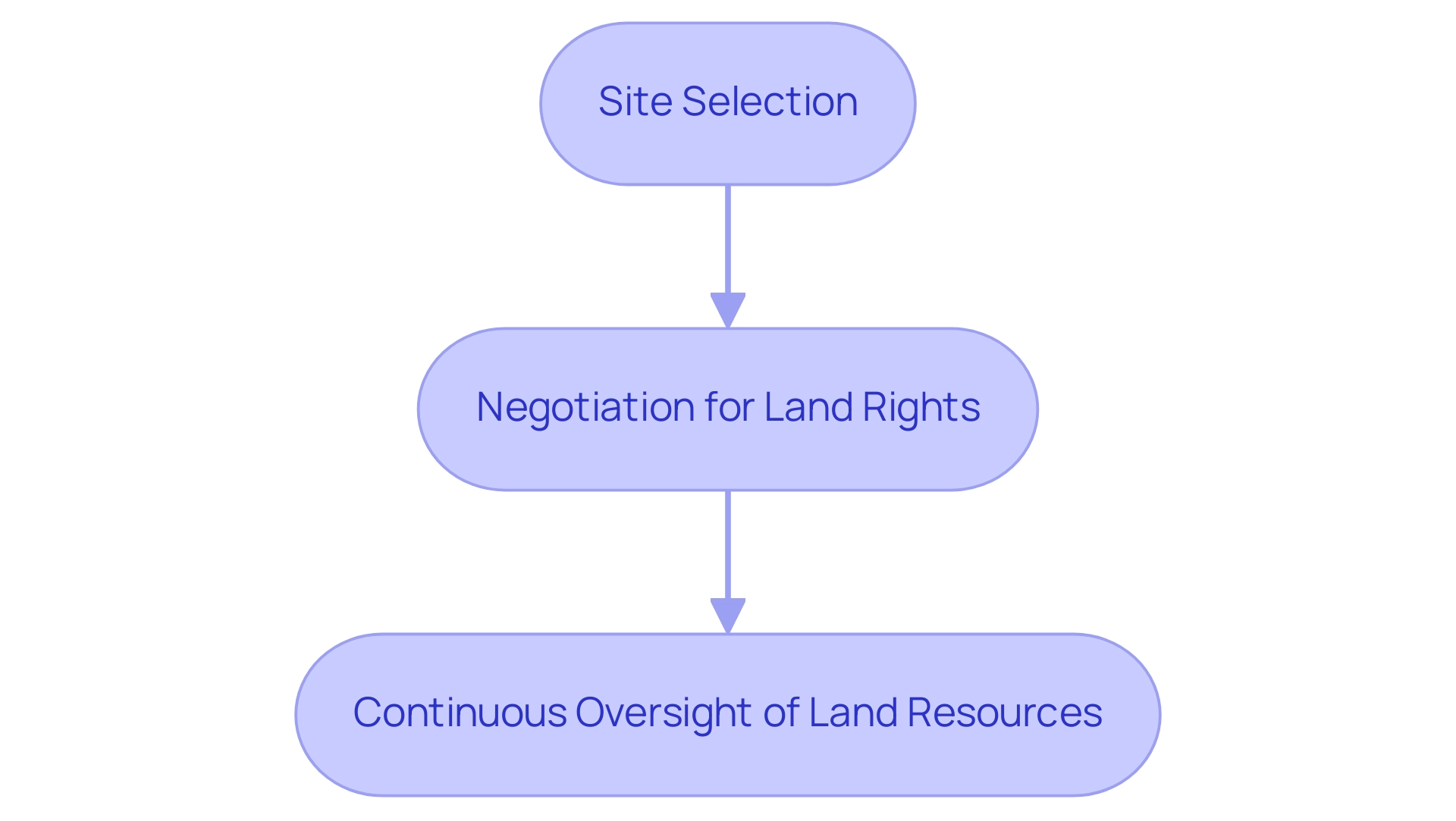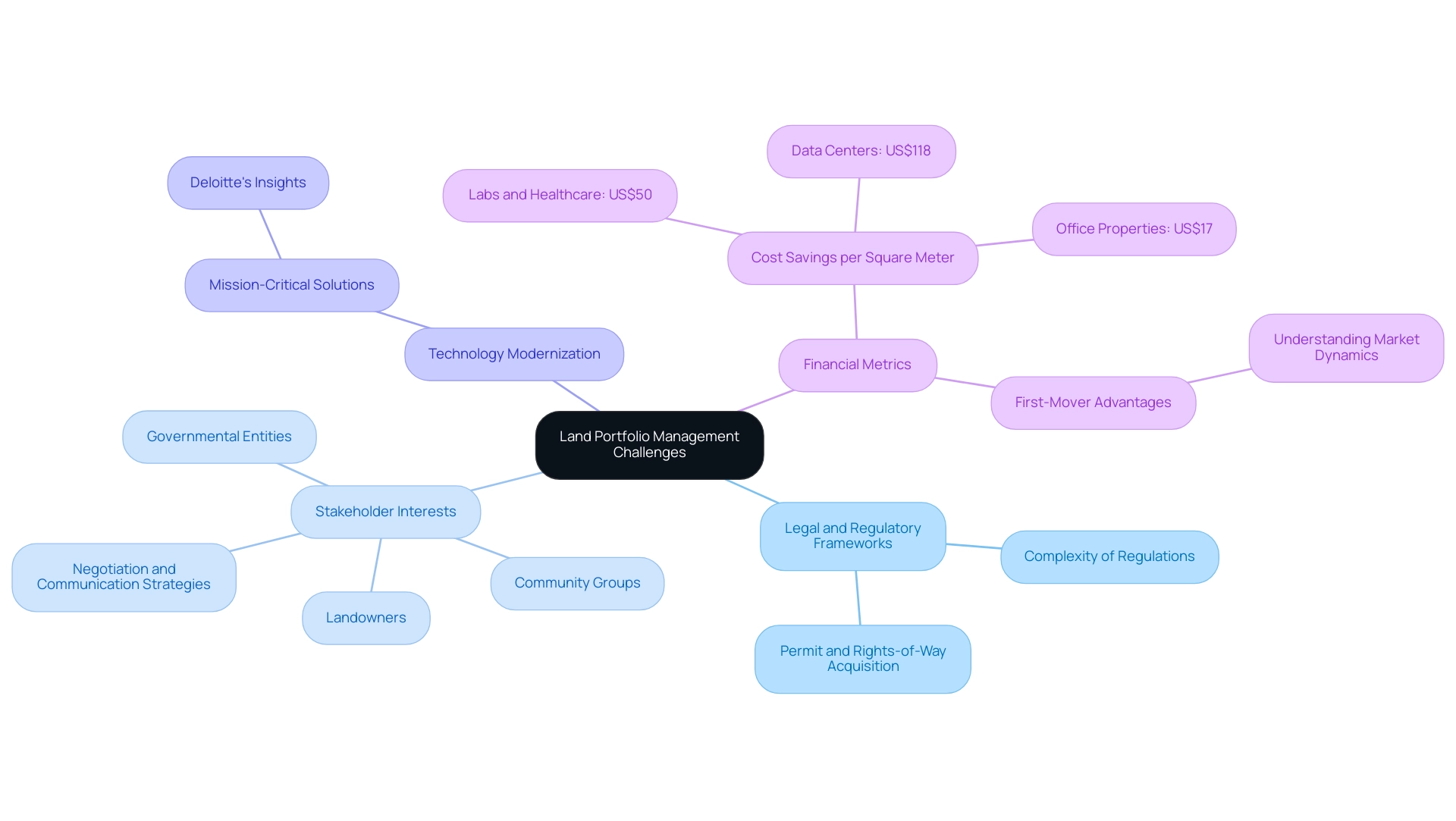Introduction
In the realm of land portfolio management, the intersection of strategic planning, technological advancement, and regulatory compliance presents both opportunities and challenges for organizations. As entities seek to acquire, manage, and optimize land assets, understanding the intricacies of land use, ownership, and zoning regulations becomes paramount. This comprehensive approach not only enhances the value of land holdings but also aligns them with broader organizational objectives.
With the increasing complexity of the legal landscape and the diverse interests of stakeholders, effective management practices are essential to navigate potential conflicts and maximize profitability. As the industry evolves, the integration of innovative technologies and sustainable practices will play a pivotal role in shaping the future of land portfolio management, ensuring that organizations remain competitive and responsive to emerging trends.
Defining Land Portfolio Management: An Overview
Land portfolio management is a strategic and systematic approach to acquiring, handling, and enhancing real estate resources to align with organizational goals. This multifaceted process requires a thorough evaluation of use, ownership, and zoning regulations, all while addressing the diverse needs of stakeholders, including government bodies, developers, and community members. By adopting effective land portfolio management practices, organizations can significantly increase the worth of their holdings, ensuring adherence to legal and regulatory frameworks.
Key activities within this domain include:
- Site selection
- Negotiation for land rights
- Continuous oversight of land resources
All aimed at supporting land portfolio management for development projects across critical sectors such as energy and infrastructure. Notably, the recent property oversight post has garnered 1,503 views, highlighting the growing interest in property-related topics. As the quote emphasizes, 'Hiring a property manager may sound like an unnecessary upfront cost, but it helps you earn maximum profits from your investment property in the long run.'
This underscores the importance of professional management services in achieving profitability. Furthermore, the case study titled 'Seeking Professional Advice' illustrates how engaging with real estate professionals and financial advisors can enhance asset performance, providing valuable insights that inform better investment decisions. As we progress into 2024, a focus on optimizing property assets for strategic objectives will be crucial as organizations aim to navigate changing usage regulations and zoning laws.

The Importance of Strategic Management in Land Portfolios
Effective land portfolio management is essential for the strategic management of property portfolios, ensuring the optimal utilization of assets in alignment with organizational objectives. This involves conducting comprehensive market analysis to identify opportunities and challenges, as well as understanding the regulatory landscape that governs property use. Authorized officers are required to perform watershed condition assessments every ten years and must also identify priority landscapes for restoration, reviewing that prioritization every five years.
These evaluations act as essential elements in guiding use planning and ensuring adherence to ecological health standards. Engaging stakeholders throughout the process fosters collaboration and anticipation of potential issues, such as zoning disputes and environmental concerns. By implementing robust strategic frameworks, organizations can make informed decisions regarding land portfolio management, as well as property acquisitions, divestitures, and development opportunities.
This proactive approach not only mitigates risks associated with usage but also enhances the profitability and sustainability of energy and infrastructure projects. As Panchita Paulete, Land Use Planning Program Lead, emphasizes, "If you have questions about this Information Bulletin, please contact me." Moreover, as emphasized in the case study named 'Land Health Evaluations and Determinations,' effective stewardship practices are essential for land portfolio management, which is crucial for attaining environmental health standards and advancing long-term ecological objectives, demonstrating the significance of assessment processes in strategic resource oversight.
Leveraging Technology for Effective Land Portfolio Management
In today's landscape of land portfolio management, technology is essential for optimizing processes and enhancing operational transparency. Geographic Information Systems (GIS) serve as a powerful tool for mapping and analyzing usage patterns. These systems enable organizations to visualize potential development sites effectively, facilitating thorough assessments of their suitability for various projects.
As noted by JLL, '57% of corporate real estate leaders surveyed indicated expansion as a top expectation through 2030,' underscoring the need for strategic planning supported by advanced technological tools. Furthermore, the integration of AI-driven title research software can dramatically streamline due diligence processes; by automating the examination of titles and ownership records, these tools minimize the time and resources required for thorough analysis. With 90% of organizations intending to speed up investments in AI over the next five years, the momentum toward technological adoption in resource oversight is clear.
The collaboration between KPMG and ServiceNow exemplifies this trend, as their partnership enhances risk oversight and operational resilience through ESG solutions that integrate digital workflows with expert insights. By utilizing these innovations, organizations can not only improve precision in assessments and lower expenses but also make more informed choices regarding acquisitions and strategies. The ongoing evolution of technology in this field, along with the necessity for continuous improvement and adaptation in the CRE function, underscores the importance of land portfolio management for property acquisition directors to stay abreast of these developments and leverage them for competitive advantage.
Navigating Challenges in Land Portfolio Management
Property oversight presents a multitude of challenges, especially in maneuvering through the complex legal and regulatory frameworks that control property use. Organizations are tasked with the crucial responsibility of obtaining necessary permits and rights-of-way, all while adhering to local, state, and federal regulations. This complexity is compounded by the diverse interests of stakeholders, including landowners, governmental entities, and community groups, which can lead to conflicts requiring adept negotiation and communication strategies.
As noted by Deloitte, modernizing technology is deemed 'mission-critical' for firms in 2024, highlighting the importance of adopting innovative solutions to meet these challenges. Financially, the potential savings from retrofitting mechanical, electrical, and plumbing systems can reach approximately:
- US$17 per square meter for office properties
- US$50 per square meter for labs and healthcare
- US$118 per square meter for data centers
Moreover, recent insights reveal promising opportunities in the office sector, particularly for high-quality assets in the most in-demand locations across all three regions.
As tenant demand increases, these assets are positioned to flourish in the changing market, emphasizing the significance of comprehending intricate market dynamics in land portfolio management to secure first-mover benefits and executing proactive strategies to maximize the value of property in energy and infrastructure projects.

Future Trends in Land Portfolio Management
The landscape of land portfolio management is experiencing notable change, fueled by various emerging trends that will influence its future. Central to this evolution is the integration of advanced technologies, particularly drone surveying equipped with Real-Time Kinematic (RTK) and Post-Processed Kinematic (PPK) technologies. Drones equipped with advanced sensors and GPS technology can capture highly precise data, which is especially beneficial in areas with limited GPS coverage, thereby enhancing data collection and analysis capabilities.
Moreover, a heightened focus on sustainable usage practices is emerging, propelled by regulatory changes and increasing public demand for environmentally responsible development. For instance, the case study titled 'Deliverables in Aerial Topography Surveys' illustrates how the number and type of deliverables, such as drawings and reports generated from survey data, significantly impact both the timing and cost of aerial surveys, particularly in complex areas and larger scopes. Organizations must respond to these trends by investing in cutting-edge technology and adopting innovative environmental practices that prioritize sustainability and stakeholder engagement.
With the increasing complexity of use regulations, there is an imperative for ongoing education and training for professionals in this field to remain informed about evolving standards and best practices. This necessity for continuous learning is essential as the regulatory landscape changes, ensuring that resource oversight practices remain compliant and effective. The interplay of these factors will be crucial in navigating the future of managing land portfolios.
Conclusion
The comprehensive examination of land portfolio management underscores its critical role in aligning land assets with organizational objectives while navigating the complexities of regulatory frameworks and stakeholder interests. By strategically acquiring, managing, and optimizing land, organizations can enhance the value of their holdings and ensure compliance with legal standards. The integration of technology, such as Geographic Information Systems and AI-driven tools, is pivotal in streamlining processes, improving decision-making, and fostering operational transparency.
Moreover, the challenges faced in this field, including regulatory navigation and stakeholder negotiations, call for robust management practices and innovative solutions. As organizations adapt to evolving market dynamics and regulatory changes, the emphasis on sustainability and strategic planning becomes increasingly significant. The insights provided highlight the necessity for ongoing education and the adoption of advanced technologies to remain competitive in an ever-changing landscape.
Looking ahead, the future of land portfolio management will be shaped by these emerging trends, including the use of drone technology and a commitment to sustainable practices. Organizations must proactively invest in these areas to ensure long-term success and responsiveness to market demands. By embracing these strategies, firms can effectively manage their land portfolios, mitigate risks, and capitalize on opportunities, ultimately driving profitability and sustainability in their operations.
Frequently Asked Questions
What is land portfolio management?
Land portfolio management is a strategic and systematic approach to acquiring, handling, and enhancing real estate resources to align with organizational goals. It involves evaluating use, ownership, and zoning regulations while addressing the needs of various stakeholders.
What are the key activities involved in land portfolio management?
Key activities include site selection, negotiation for land rights, and continuous oversight of land resources, all aimed at supporting development projects in sectors like energy and infrastructure.
Why is professional management important in land portfolio management?
Professional management services help organizations maximize profits from their investment properties in the long run by ensuring effective oversight and adherence to legal and regulatory frameworks.
How does technology impact land portfolio management?
Technology, such as Geographic Information Systems (GIS) and AI-driven software, enhances operational transparency, streamlines due diligence processes, and improves decision-making regarding acquisitions and strategies.
What challenges do organizations face in property oversight?
Organizations encounter complex legal and regulatory frameworks, the need for permits and rights-of-way, and diverse stakeholder interests, which can lead to conflicts requiring effective negotiation and communication.
What trends are influencing the future of land portfolio management?
Emerging trends include the integration of advanced technologies like drone surveying, a focus on sustainable practices due to regulatory changes, and the necessity for continuous education and training for professionals in the field.
How can stakeholder engagement benefit land portfolio management?
Engaging stakeholders fosters collaboration and helps anticipate potential issues, such as zoning disputes and environmental concerns, leading to more informed and effective management decisions.
What role do assessments play in land portfolio management?
Assessments, such as watershed condition evaluations, guide use planning and ensure compliance with ecological health standards, which are essential for sustainable land management.
List of Sources
- Defining Land Portfolio Management: An Overview
- Updated Property Management Statistics And Information for 2024 (https://ngbmanagement.com/post/property-management-statistics-and-information)
- The Dos and Don'ts of Portfolio Management in 2024 (https://propertymanagementpleasanton.com/blog/the-dos-and-donts-of-portfolio-management-in-2024)
- The Importance of Strategic Management in Land Portfolios
- Strategic Land Planning: Balancing Development and Conservation - Matthews | DCCM (https://mdginc.com/2024/05/20/strategic-land-planning-balancing-development-and-conservation)
- Land Use Planning and the Conservation and Landscape Health Rule | Bureau of Land Management (https://blm.gov/policy/ib-2024-048)
- Leveraging Technology for Effective Land Portfolio Management
- Global occupier trends to watch in 2025 (https://us.jll.com/en/trends-and-insights/research/top-global-cre-trends)
- Project Portfolio Management Market 2024 to 2034: Unveiling a Growth Journey at 8.7% CAGR | Future Market Insights, Inc. (https://finance.yahoo.com/news/project-portfolio-management-market-2024-020000938.html)
- Navigating Challenges in Land Portfolio Management
- us.jll.com (https://us.jll.com/en/trends-and-insights/research/global/global-real-estate-outlook)
- pereviewsoftware.com (https://pereviewsoftware.com/cre-resources/2024s-top-5-commercial-real-estate-reporting-challenges-asset-managers-face-and-new-ways-tech-like-ai-and-automation-are-solving-them)
- Future Trends in Land Portfolio Management
- Drone Surveying Guide: Why UAV Surveying is the Future (https://thedroneu.com/blog/drone-surveying)
- Factors Impacting Cost Of Aerial Drone Land Surveying | Diamond Land Surveying (https://diamondlandsurveying.com/factors-impacting-cost-of-aerial-drone-land-surveying)




